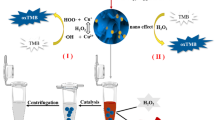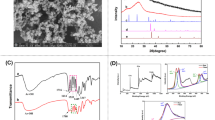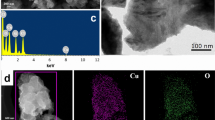Abstract
To prepare a robust biocatalyst and enhance the removal of bisphenol A in wastewater, succinic anhydride was reacted with laccase to obtain succinic anhydride-modified laccase (SA-laccase) and then co-crystallized with Cu3(PO4)2 to form SA-laccase@Cu3(PO4)2 hybrid nanoflowers (hNFs). The activity of SA-laccase@Cu3(PO4)2 reached 5.27 U/mg, 1.86-, 2.88- and 2.15-fold those of bare laccase@Cu3(PO4)2, laccase@Ca3(PO4)2 and laccase@epoxy resin, respectively. Compared with free laccase, the obtained hNFs present enhanced activity and tolerance to pH and high temperature in the removal of BPA. Under the optimum conditions of pH 6.0 and 35 °C, BPA removal reached 93.2% using SA-laccase@Cu3(PO4)2 hNFs, which was 1.21-fold of that using free laccase. In addition, the obtained SA-laccase@Cu3(PO4)2 hNFs retained nearly 90% of their initial catalytic activity for BPA removal after 8 consecutive batch cycles. This efficient method for preparing immobilized laccase can also be further developed and improved to acquire green biocatalysts for removing persistent organic pollutants in wastewater.
Graphic abstract














Similar content being viewed by others
References
Rahman MF, Yanful EK, Jasim SY (2009) Occurrences of endocrine disrupting compounds and pharmaceuticals in the aquatic environment and their removal from drinking water: challenges in the context of the developing world. Desalination 248(1–3):578–585
Loffredo E, Castellana G, Senesi N (2014) Decontamination of a municipal landfill leachate from endocrine disruptors using a combined sorption/bioremoval approach. Environ Sci Pollut Res 21(4):2654–2662
Joseph L, Zaib Q, Khan IA, Berge ND, Park YG, Saleh NB, Yoon Y (2011) Removal of bisphenol A and 17 alpha-ethinyl estradiol from landfill leachate using single-walled carbon nanotubes. Water Res 45(13):4056–4068
De Freitas EN, Bubna GA, Brugnari T, Kato CG, Nolli M, Rauen TG, Moreira R, Peralta RA, Bracht A, De Souza CGM, Peralta RM (2017) Removal of bisphenol A by laccases from Pleurotus ostreatus and Pleurotus pulmonarius and evaluation of ecotoxicity of degradation products. Chem Eng J 330:1361–1369
Dekant W, Voelkel W (2008) Human exposure to bisphenol A by biomonitoring: methods, results and assessment of environmental exposures. Toxicol Appl Pharmacol 228(1):114–134
Wang GH, Qi PR, Xue XF, Wu F, Deng NS (2007) Photodegradation of bisphenol Z by UV irradiation in the presence of beta-cyclodextrin. Chemosphere 67(4):762–769
Chen PJ, Linden KG, Hinton DE, Kashiwada S, Rosenfeldt EJ, Kullman SW (2006) Biological assessment of bisphenol A degradation in water following direct photolysis and UV advanced oxidation. Chemosphere 65(7):1094–1102
Deng B, Li YT, Tan WH, Wang ZX, Yu ZW, Xing SY, Lin H, Zhang H (2018) Degradation of bisphenol A by electro-enhanced heterogeneous activation of peroxydisulfate using Mn-Zn ferrite from spent alkaline Zn-Mn batteries. Chemosphere 204:178–185
Zhang YM, Zhang DD, Zhou LC, Zhao YL, Chen J, Chen Z, Wang F (2018) Polypyrrole/reduced graphene oxide aerogel particle electrodes for high-efficiency electro-catalytic synergistic removal of Cr(VI) and bisphenol A. Chem Eng J 336:690–700
Chan YY, Yue YN, Li YX, Webster RD (2013) Electrochemical/chemical oxidation of bisphenol A in a four-electron/two-proton process in aprotic organic solvents. Electrochim Acta 112:287–294
Sharma B, Dangi AK, Shukla P (2018) Contemporary enzyme based technologies for bioremediation: a review. J Environ Manag 210:10–22
Villegas LGC, Mashhadi N, Chen M, Mukherjee D, Taylor KE, Biswas N (2016) A short review of techniques for phenol removal from wastewater. Curr Pollut Rep 2(3):157–167
Bernal C, Rodriguez K, Martinez R (2018) Integrating enzyme immobilization and protein engineering: an alternative path for the development of novel and improved industrial biocatalysts. Biotechnol Adv 36(5):1470–1480
Valencia D, Guillen M, Furst M, Lopez-Santin J, Alvaro G (2018) An immobilized and highly stabilized self-sufficient monooxygenase as biocatalyst for oxidative biotransformations. J Chem Technol Biotechnol 93(4):985–993
Ge J, Lei JD, Zare RN (2012) Protein-inorganic hybrid nanoflowers. Nat Nanotechnol 7(7):428–432
Yu JY, Chen XX, Jiang M, Wang AM, Yang LL, Pei XL, Zhang PF, Wu SG (2018) Efficient promiscuous Knoevenagel condensation catalyzed by papain confined in Cu3(PO4)2 nanoflowers. RSC Adv 8(5):2357–2364
Chen YT, Hu SY, Chen DJ, Zhai HX, Bao ST, Lv TB (2019) An evaluation method of green development for chemical enterprises. Sustainability 11(22):6491
Cui JD, Jia SR (2017) Organic–inorganic hybrid nanoflowers: a novel host platform for immobilizing biomolecules. Coord Chem Rev 352:249–263
Lei ZX, Gao CL, Chen L, He YT, Ma WD, Lin ZA (2018) Recent advances in biomolecule immobilization based on self-assembly: organic–inorganic hybrid nanoflowers and metal–organic frameworks as novel substrates. J Mater Chem B 6(11):1581–1594
Li ZX, Zhang YF, Su YC, Ouyang PK, Ge J, Liu Z (2014) Spatial co-localization of multi-enzymes by inorganic nanocrystal–protein complexes. Chem Commun 50(83):12465–12468
Zhang BL, Li PT, Zhang HP, Wang H, Li XJ, Tian L, Ali N, Ali Z, Zhang QY (2016) Preparation of lipase/Zn-3(PO4)(2) hybrid nanoflower and its catalytic performance as an immobilized enzyme. Chem Eng J 291:287–297
Brenna O, Bianchi E (1994) Immobilised laccase for phenolic removal in must and wine. Biotechnol Lett 16(1):35–40
Hublik S (2000) Characterization and immobilization of the laccase from Pleurotus ostreatus and its use for the continuous elimination of phenolic pollutants. Enzyme Microb Technol 27(3–5):330–336
Guzik U, Hupert-Kocurek K, Wojcieszynska D (2014) Immobilization as a strategy for improving enzyme properties-application to oxidoreductases. Molecules 19(7):8995–9018
Brugnari T, Pereira MG, Bubna GA, De Freitas EN, Contato AG, Correa RCG, Castoldi R, De Souza CGM, Polizeli M, Bracht A, Peralta RM (2018) A highly reusable MANAE-agarose-immobilized Pleurotus ostreatus laccase for degradation of bisphenol A. Sci Total Environ 634:1346–1351
Mate DM, Alcalde M (2017) Laccase: a multi-purpose biocatalyst at the forefront of biotechnology. Microb Biotechnol 10(6):1457–1467
Barrios-Estrada C, Rostro-Alanis MD, Munoz-Gutierrez BD, Iqbal HMN, Kannan S, Parra-Saldivar R (2018) Emergent contaminants: endocrine disruptors and their laccase-assisted degradation—a review. Sci Total Environ 612:1516–1531
Li X, Lv PF, Yao YX, Feng Q, Mensah A, Li DW, Wei QF (2020) A novel single-enzymatic biofuel cell based on highly flexible conductive bacterial cellulose electrode utilizing pollutants as fuel. Chem Eng J 379:122316
Bilal M, Rasheed T, Nabeel F, Iqbal HMN, Zhao YP (2019) Hazardous contaminants in the environment and their laccase-assisted degradation—a review. J Environ Manag 234:253–264
Taheran M, Naghdi M, Brar SK, Knystautas EJ, Verma M, Surampalli RY (2017) Degradation of chlortetracycline using immobilized laccase on Polyacrylonitrile-biochar composite nanofibrous membrane. Sci Total Environ 605:315–321
Bilal M, Iqbal HMN, Barcelo D (2019) Mitigation of bisphenol A using an array of laccase-based robust bio-catalytic cues—a review. Sci Total Environ 689:160–177
Fu MH, Xing JF, Ge ZQ (2019) Preparation of laccase-loaded magnetic nanoflowers and their recycling for efficient degradation of bisphenol A. Sci Total Environ 651:2857–2865
Lassouane F, Ait-Amar H, Amrani S, Rodriguez-Couto S (2019) A promising laccase immobilization approach for bisphenol A removal from aqueous solutions. Bioresour Technol 271:360–367
Zdarta J, Antecka K, Frankowski R, Zgola-Grzeskowiak A, Ehrlich H, Jesionowski T (2018) The effect of operational parameters on the biodegradation of bisphenols by Trametes versicolor laccase immobilized on Hippospongia communis spongin scaffolds. Sci Total Environ 615:784–795
Fernandez-Fernandez M, Sanroman MA, Moldes D (2013) Recent developments and applications of immobilized laccase. Biotechnol Adv 31(8):1808–1825
D'souza S (1999) Immobilized enzymes in bioprocess. Curr Sci 77:69–79
Tischer W, Wedekind F (1999) Immobilized enzymes: methods and applications. In: Fessner WD et al (eds) Biocatalysis-from discovery to application topics in current chemistry, vol 200. Springer, Berlin, Heidelberg
Ardao I, Magnin D, Agathos SN (2015) Bioinspired production of magnetic laccase-biotitania particles for the removal of endocrine disrupting chemicals. Biotechnol Bioeng 112(10):1986–1996
Chen Y, Wan J, Wu Q, Ma Y (2017) Chemical modification of laccase from Aspergillus oryzae and its application in OCC pulp. BioResources 12(1):673–683
Ren D, Zhang Y, Xu Q, Wang C, Wang T, Huang S, Zhang S (2013) Effects of chemical modification on laccase stability and degradation of indole. J Pure Appl Microbiol 7:765–770
Bradford MM (1976) A rapid and sensitive method for the quantitation of microgram quantities of protein utilizing the principle of protein-dye binding. Anal Biochem 72:248–254
Mota TR, Kato CG, Peralta RA, Bracht A, De Morais GR, Baesso ML, De Souza CGM, Peralta RM (2015) Decolourization of Congo red by Ganoderma lucidum laccase: evaluation of degradation products and toxicity. Water Air Soil Pollut 226(10):1–11
Kimura Y, Takahashi A, Kashiwada A, Yamada K (2016) Removal of bisphenol A and its derivatives from aqueous medium through laccase-catalyzed treatment enhanced by addition of polyethylene glycol. Environ Technol 37(14):1733–1744
Ke C, Fan Y, Chen Y, Xu L, Yan Y (2016) A new lipase-inorganic hybrid nanoflower with enhanced enzyme activity. RSC Adv 6(23):19413–19416
Wang A, Chen X, Yu J, Li N, Li H, Yin Y, Xie T, Wu SG (2020) Green preparation of lipase@Ca3(PO4)2 hybrid nanoflowers using bone waste from food production for efficient synthesis of clindamycin palmitate. J Ind Eng Chem 89:383–391
Speight JG, Lange N (2005) Lange’s handbook of chemistry, 16th edn. McGraw-Hill, New York
Habraken W, Tao JH, Brylka LJ, Friedrich H, Bertinetti L, Schenk AS, Verch A, Dmitrovic V, Bomans PHH, Frederik PM, Laven J, Van Der Schoot P, Aichmayer B, De With G, Deyoreo JJ, Sommerdijk N (2013) Ion-association complexes unite classical and non-classical theories for the biomimetic nucleation of calcium phosphate. Nat Commun 4:1–12
Amirkhani L, Moghaddas J, Jafarizadeh-Malmiri H (2016) Candida rugosa lipase immobilization on magnetic silica aerogel nanodispersion. RSC Adv 6(15):12676–12687
Guin D, Gruebele M (2019) Weak chemical interactions that drive protein evolution: crowding, sticking, and quinary structure in folding and function. Chem Rev 119(18):10691–10717
Jiang M, Guo Z (2007) Effects of macromolecular crowding on the intrinsic catalytic efficiency and structure of enterobactin-specific isochorismate synthase. J Am Chem Soc 129(4):730–731
Lee SW, Cheon SA, Kim MI, Park TJ (2015) Organic–inorganic hybrid nanoflowers: types, characteristics, and future prospects. J Nanobiotechnol 13:54
Rong J, Zhang T, Qiu FX, Rong XS, Zhu XL, Zhang XY (2016) Preparation of hierarchical micro/nanostructured Bi2S3-WO3 composites for enhanced photocatalytic performance. J Alloys Compd 685:812–819
Kong J, Yu S (2007) Fourier transform infrared spectroscopic analysis of protein secondary structures. Acta Biochim Biophys Sin 39(8):549–559
Marschelke C, Mueller M, Koepke D, Matura A, Sallat M, Synytska A (2019) Hairy particles with immobilized enzymes: impact of particle topology on the catalytic activity. ACS Appl Mater Interfaces 11(1):1645–1654
Xie M, Liu Y (2003) Studies on amide III infrared bands for the secondary structure determination of proteins. Chem J Chin Univ 24(2):226–231
Wang Z, Ren D, Yu H, Jiang S, Zhang S, Zhang X (2020) Study on improving the stability of adsorption-encapsulation immobilized Laccase@ZIF-67. Biotechnol Rep (Amst) 28:e00553–e00553
Kadam AA, Shinde SK, Ghodake GS, Saratale GD, Saratale RG, Sharma B, Hyun S, Sung J-S (2020) Chitosan-grafted halloysite nanotubes-Fe3O4 composite for laccase-immobilization and sulfamethoxazole-degradation. Polymers 12(10):2221
Muthuvelu KS, Rajarathinam R, Selvaraj RN, Rajendren VB (2020) A novel method for improving laccase activity by immobilization onto copper ferrite nanoparticles for lignin degradation. Int J Biol Macromol 152:1098–1107
Ramirez-Cavazos LI, Junghanns C, Ornelas-Soto N, Cardenas-Chavez DL, Hernandez-Luna C, Demarche P, Enaud E, Garcia-Morales R, Agathos SN, Parra R (2014) Purification and characterization of two thermostable laccases from Pycnoporus sanguineus and potential role in degradation of endocrine disrupting chemicals. J Mol Catal B Enzym 108:32–42
Piontek K, Antorini M, Choinowski T (2002) Crystal structure of a laccase from the fungus Trametes versicolor at 1.90-angstrom resolution containing a full complement of coppers. J Biol Chem 277(40):37663–37669
Baldrian P (2006) Fungal laccases—occurrence and properties. FEMS Microbiol Rev 30(2):215–242
Khaparde SS, Singhal RS (2001) Chemically modified papain for applications in detergent formulations. Bioresour Technol 78(1):1–4
Xiong Y, Gao J, Zheng J, Deng N (2011) Effects of succinic anhydride modification on laccase stability and phenolics removal efficiency. Chin J Catal 32(10):1584–1591
Yang HL, Chen Y, Xin Y, Zhang L, Zhang YR, Wang W (2013) Chemically modified sepharose as support for the immobilization of cholesterol oxidase. J Microbiol Biotechnol 23(9):1212–1220
Arıca MY, Bayramoǧlu G, Bıçak N (2004) Characterisation of tyrosinase immobilised onto spacer-arm attached glycidyl methacrylate-based reactive microbeads. Process Biochem 39(12):2007–2017
Bayramoglu G, Arica MY (2008) Enzymatic removal of phenol and p-chlorophenol in enzyme reactor: horseradish peroxidase immobilized on magnetic beads. J Hazard Mater 156(1–3):148–155
Yoon J, Liboiron BD, Sarangi R, Hodgson KO, Hedman B, Solomona EI (2007) The two oxidized forms of the trinuclear Cu cluster in the multicopper oxidases and mechanism for the decay of the native intermediate. Proc Natl Acad Sci USA 104(34):13609–13614
Lin J, Liu Y, Chen S, Le X, Zhou X, Zhao Z, Ou Y, Yang J (2016) Reversible immobilization of laccase onto metal-ion-chelated magnetic microspheres for bisphenol A removal. Int J Biol Macromol 84:189–199
Li D-F, Ding H-C, Zhou T (2013) Covalent immobilization of mixed proteases, trypsin and chymotrypsin, onto modified polyvinyl chloride microspheres. J Agric Food Chem 61(44):10447–10453
Maurya SS, Nadar SS, Rathod VK (2020) Dual activity of laccase-lysine hybrid organic–inorganic nanoflowers for dye decolourization. Environ Technol Innov 19:100798
Cui J, Zhao Y, Liu R, Zhong C, Jia S (2016) Surfactant-activated lipase hybrid nanoflowers with enhanced enzymatic performance. Sci Rep 6:1–13
Piao MY, Zou DL, Yang YS, Ren XH, Qin CY, Piao YX (2019) Multi-functional laccase immobilized hydrogel microparticles for efficient removal of bisphenol A. Materials 12(5):704
Wang H, Liu Z-H, Zhang J, Huang R-P, Yin H, Dang Z, Wu P-X, Liu Y (2019) Insights into removal mechanisms of bisphenol A and its analogues in municipal wastewater treatment plants. Sci Total Environ 692:107–116
Zhu P, Wang Y, Li G, Liu K, Liu Y, He J, Lei J (2019) Preparation and application of a chemically modified laccase and copper phosphate hybrid flower-like biocatalyst. Biochem Eng J 144:235–243
Bhatnagar A, Anastopoulos L (2017) Adsorptive removal of bisphenol A (BPA) from aqueous solution: a review. Chemosphere 168:885–902
Hider RC, Liu ZD, Khodr HH (2001) Metal chelation of polyphenols. Methods Enzymol 335:190–203
Acknowledgements
This study was supported by the National Natural Science Foundation of China (22078079, 81730108), the Natural Science Foundation of Zhejiang Province (LY18B060009), the National Innovation and Entrepreneurship Training Program for Undergraduate (201810346008), the “Star and light” Project for Talent Students in Hangzhou Normal University (2019) and Research Plan for Sprout Talents in University in Zhejiang Province (2020R427071).
Author information
Authors and Affiliations
Corresponding authors
Ethics declarations
Conflict of interest
The authors declare that they have no conflict of interest.
Additional information
Publisher's Note
Springer Nature remains neutral with regard to jurisdictional claims in published maps and institutional affiliations.
Rights and permissions
About this article
Cite this article
Yang, H., He, P., Yin, Y. et al. Succinic anhydride-based chemical modification making laccase@Cu3(PO4)2 hybrid nanoflowers robust in removing bisphenol A in wastewater. Bioprocess Biosyst Eng 44, 2061–2073 (2021). https://doi.org/10.1007/s00449-021-02583-x
Received:
Accepted:
Published:
Issue Date:
DOI: https://doi.org/10.1007/s00449-021-02583-x




